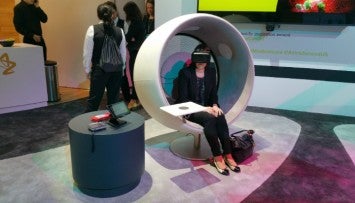After the release of the Oculus Rift at the Consumer Electronics Show, the world really got to understand what can be achieved with virtual reality or VR – and not just for brands in shopping centres, but for gamers in their home.
Starting this year you’ll be able to link your headset to your Xbox and you’ll be dancing around the living room with it. So now we’ve all heard the term and we’ve had our balance challenged on the sofa, how can VR be used to create a brand experience that is both immersive and actually practical?
VR grabs 100 per cent of the consumer’s attention, enabling you alone-time with that person to deliver your experience, which means, if you get the content right, you can cut through in a noisy world
Event technology specialists Arcstream have worked at the cutting edge of event technology for the last 20 years, bringing ideas to life with bespoke technical solutions for event organisers all over the world. They were the team behind interactive experiences in the Pepsi Max Cube on the South Bank in London, the hugely popular interactive projections in Frankfurt Airport for EMC² and the Grolsch roadshow’s ultimate photo booth that visited public spaces throughout the country last year.
They are championing VR experiences as a vital element for events in 2016 and beyond, enabling you to visualise the experience for the consumer, take them through the yet to be constructed building or personalise their journey around brands – the applications are endless. Let potential customers see prototype cars and give feedback ahead of release, let people walk around a mega-yacht, test out your new store concept or create a virtual party environment that changes every 15 minutes.
 Now the really amazing thing about VR that makes it worth the investment for brands above all else is the undivided attention it affords you with your consumer, while they are immersed in the experience. At all other times of the day you are constantly distracted by multiple things, playing on your phone while shopping, browsing the news while watching television. VR grabs 100 per cent of the consumer’s attention, enabling you alone-time with that person to deliver your experience, which means, if you get the content right, you can cut through in a noisy world.
Now the really amazing thing about VR that makes it worth the investment for brands above all else is the undivided attention it affords you with your consumer, while they are immersed in the experience. At all other times of the day you are constantly distracted by multiple things, playing on your phone while shopping, browsing the news while watching television. VR grabs 100 per cent of the consumer’s attention, enabling you alone-time with that person to deliver your experience, which means, if you get the content right, you can cut through in a noisy world.
Not all events or brands will benefit from this kind of experience, however, and this is where touchscreens are coming into their own for events in 2016. While the versions we know from years gone by were unresponsive and the content poorly designed, the time for a fantastic experience is now.
Event-goers now expect more than just a presentation to flick through virtually or an interactive floorplan which simply flashes with a location map for your event. Just think what a map can deliver, simply and intuitively. The destination would have a pop-up video of its product’s latest product lines, while an event map would highlight the number of steps to get to that chosen exhibition stand, so you feel virtuous on the way.
Touch applications can now be developed with a bespoke journey for every user. More interestingly, the latest touch technology can receive information as well as give it, using object or fiducial code recognition to deliver tailored experiences to the user, taking them through a brand story using their preferences, captured by scanning the badge of an exhibition attendee, for example.
You can tailor your event invitation, giving attendees a personal greeting on-site and then allowing them to request information to be sent to them via their preferred mode. More importantly, it allows brands to database what the user has been exploring and their contact detail to follow up in a sales process later.
 Arcstream demonstrated this recently at the QuickBooks Connect 2015 US event in San Jose, for INTUIT. By accessing the attendee database in real time, users could scan their pass on a touch table to create a totally personalised experience for them.
Arcstream demonstrated this recently at the QuickBooks Connect 2015 US event in San Jose, for INTUIT. By accessing the attendee database in real time, users could scan their pass on a touch table to create a totally personalised experience for them.
By then using a selection of pucks placed on the surface, the table revealed specific apps relevant to their business areas. The user could quickly see the details of each app, along with ratings and demos, and most importantly, they could add apps to their personal wish list, dragging and dropping the information with their finger.
After the event, each person who logged into the table was sent an e-mail containing their wish list and the option to download the apps they saved, extending the event experience.
It’s an old adage – at least two-years-old anyway – but content is still king, more than ever though it’s the idea that is king, as well as the way it is presented. The guys with the best ideas, executed professionally will be the winners at events as the tools are better than ever.


